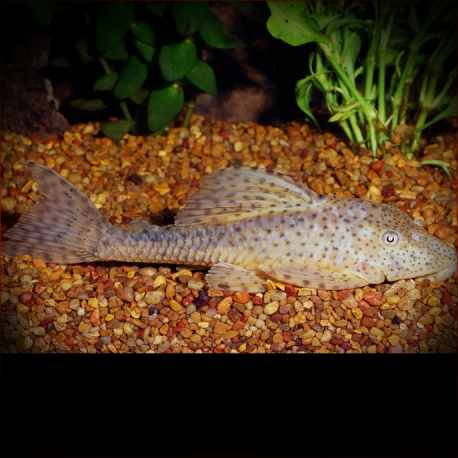More info
Datasheet
| Minimum Tank Size | 243 litres / 64.19 US gallons |
| Maximum Size | 23.0cm / 9.06inches |
| Temperature | 21°C / 69.80°F - 24°C / 75.20°F |
| Hardness | 5-18ºdH |
| pH | 6.3-7.2 |
General Description:
The Spotted Cochliodon, also known as L050 or Hypostomus cf. Cochliodon, is an undescribed species within the Hypostomus cochliodon complex, previously categorized under the genus Cochliodon. It is characterized by a hump-backed profile in mature specimens and spoon-shaped dentition. This species has a unique wood-eating habit, a specialized adaptation that sets it apart as the only known xylophagus fish. Their affinity for wood consumption is believed to have evolved due to their natural habitat where fallen wood is abundant on the substrate, supporting their competitive advantage in areas with limited light penetration.
Aquarium Setup:
To house the Spotted Cochliodon, a spacious tank of at least 243 liters is recommended, featuring a sandy substrate and ample hiding spots provided by large pieces of driftwood, which are essential for their diet. Dim lighting, absence of aquatic plants, and the presence of some surface vegetation are ideal. Well-oxygenated water with good flow dynamics, maintained at a temperature range of 21-24°C, and a pH of 6.3-7.2, with moderate hardness (5-18°dH), are crucial for their well-being (see table).
Behaviour:
This species demonstrates amicable behavior and can cohabit with various tankmates as long as their oxygen needs are met. They are non-territorial and can be kept in groups with conspecifics or alongside other peaceful Loricariids. However, smaller tankmates might feel intimidated by their size.
Feeding and Diet:
Being primarily xylophagus, the Spotted Cochliodon relies on wood as a staple food source, with the gut filled with wood chips and specialized bacteria aiding in digestion. They also enjoy feeding on greenery such as cucumber, courgette, blanched spinach, in addition to sinking dried foods for a balanced diet.
Reproduction & Dimorphism:
Information about the reproduction and sexual dimorphism of the Spotted Cochliodon remains unknown, and they have not been successfully bred in captivity as of now.
Habitat and Distribution:
Although precise distribution details are unavailable, based on other members of its group, the Spotted Cochliodon likely inhabits flowing parts of rivers and streams, particularly around driftwood structures.

